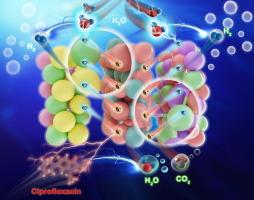Integrating photocatalytic hydrogen evolution with antibiotic degradation over a dual Z-scheme heterojunction
IF 13.3
1区 工程技术
Q1 ENGINEERING, CHEMICAL
引用次数: 0
Abstract
The excessive usage of value-added sacrificial agents and poor carrier separation constrain the development of photocatalytic H2 production. To address these challenges, we propose a waste-to-energy conception by utilizing pollutants as sacrificial agents in heterojunctions with potent carrier separation. Herein, a dual Z-scheme ZnCo2O4/C-TiO2/ZnIn2S4 (ZCO/CTO/ZIS) heterojunction was successfully constructed from MOFs with effective carrier separation to integrate H2 production and organic pollutants degradation in a single photo-redox process. When ciprofloxacin (CIP), a prevalent aquatic contaminant, was substituted for the sacrificial agents to utilize the energy of holes, the dual Z-scheme photocatalyst exhibited excellent hydrogen production performance (∼4.93 ). Concurrently, the degradation of CIP was up to 92.21 %, with a 66.71 % mineralization rate. The experimental results combined with theoretical calculations revealed that the interfacial electron field formed at dual Z-scheme ZCO/CTO/ZIS affords fast pathways for charge transfer to achieve the high performance of simultaneous reactions. Additionally, the low toxicity of the degradation intermediates during the bifunctional photocatalysis process implies that this is an environment-friendly route to obtain clean energy. This study provides a feasible strategy for constructing dual Z-scheme photocatalysts from MOFs to alleviate energy crises and environmental pollution.

求助全文
约1分钟内获得全文
求助全文
来源期刊

Chemical Engineering Journal
工程技术-工程:化工
CiteScore
21.70
自引率
9.30%
发文量
6781
审稿时长
2.4 months
期刊介绍:
The Chemical Engineering Journal is an international research journal that invites contributions of original and novel fundamental research. It aims to provide an international platform for presenting original fundamental research, interpretative reviews, and discussions on new developments in chemical engineering. The journal welcomes papers that describe novel theory and its practical application, as well as those that demonstrate the transfer of techniques from other disciplines. It also welcomes reports on carefully conducted experimental work that is soundly interpreted. The main focus of the journal is on original and rigorous research results that have broad significance. The Catalysis section within the Chemical Engineering Journal focuses specifically on Experimental and Theoretical studies in the fields of heterogeneous catalysis, molecular catalysis, and biocatalysis. These studies have industrial impact on various sectors such as chemicals, energy, materials, foods, healthcare, and environmental protection.
 求助内容:
求助内容: 应助结果提醒方式:
应助结果提醒方式:


